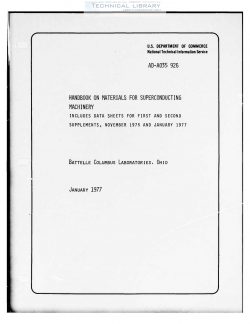MCIC-HB-04S2
- Version
- 244 Downloads
- 53.34 MB File Size
- 1 File Count
- March 5, 2017 Create Date
- March 5, 2017 Last Updated
Second Supplement to the Handbook on Materials for Superconducting Machinery

Recent advancements in the development of superconducting machinery have demonstrated that superconducting generators, motors, transrnissjon lines, and Other electrical equipment are more efficient, occupy less space for equivalent capacity, and have other advantages over more conventional equipment. Because of theæ advantages, there is considerable incentive to develop superconducting systems for certain military applications. New ship propulsion systems which are being developed by the Navy represent major developments in superconducting generators, motors, and controls. These developments involve considerable new design technology and en- vironments that may expose the components to cryogenic temperatures as low as 4 K. Exposure of structural materials to such low temperatures affects the mechanical and physical properties of the materials. The purpose of the Handbook is to provide a ready reference for designers on the effects of low temperatures on the properties of structural materials that will be considered in developing new designs for superconducting machinery. Formats for presentation of the me- chanical, thermal, electrical, and magnetic property data are intended to provide best-value data for the designer based on currently available information. The data also may be used by engi- neers in selecting materials for certain cryogenic applications. The current list of materials was selected based on available information and suitability for such applications. All data are based on current state-of-the-art information.
The structural materials property data presented in this Handbook are based on compilations of data collected from documents in the files ot the Metals and Ceramics Information Center (MCIC). These documents either were originally part of the data base of MCIC or were acquired as a result of a search of the accessions of the Cryogenic Data Center, Cryogenics Division, National Bureau of Standards, Boulder, Colorado. Documents from which the data were obtained are listed in the Reference section according to MCIC accession number. The Bibliogr-phy, which includes cited data references, lists over 900 citations on properties and applications of the selected materials. The 18 references for the composite materials are listed at the end of Section 1 1, Composites. When more detailed information is needed than the best-value data presented in later sections of this Handbook, the original sources Of the data should be consulted.
| File | Action |
|---|---|
| MCIC-HB-04S2 Second Supplement to the Handbook on Materials for Superconducting Machinery.pdf | Download |

Comment On This Post